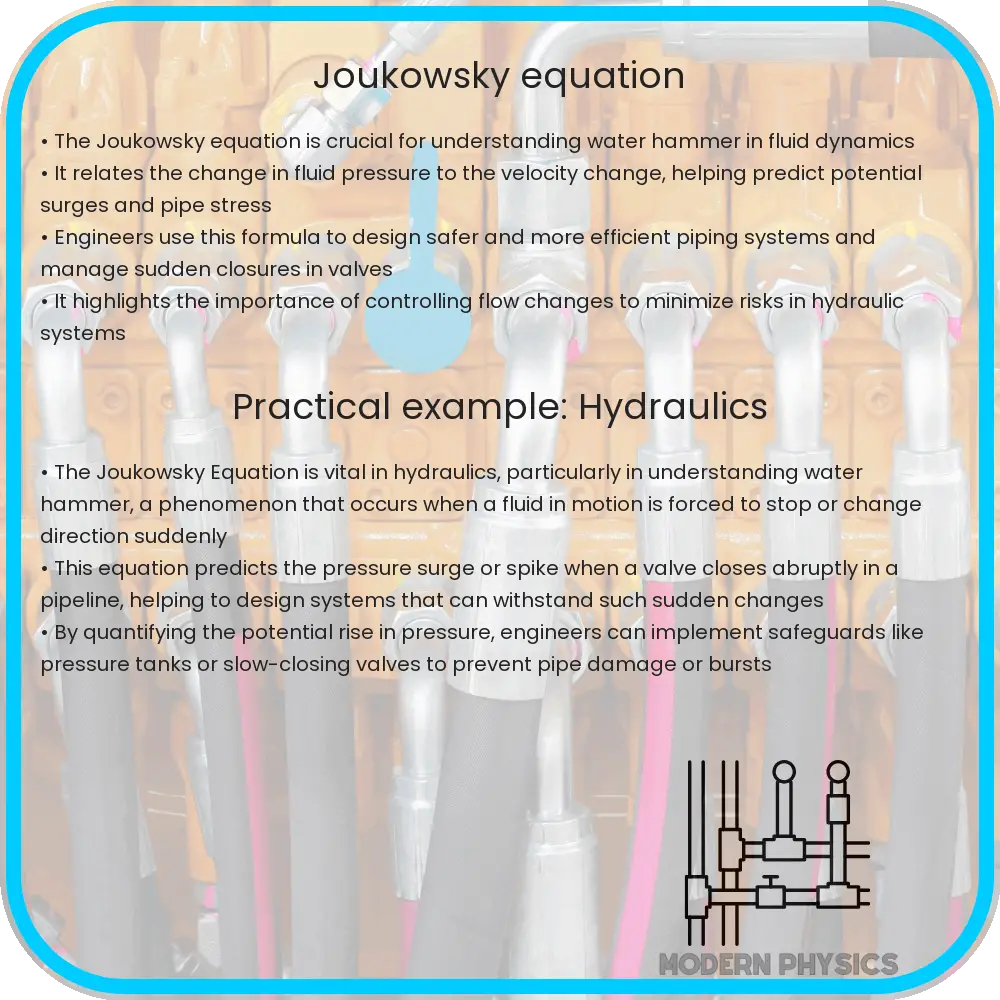The Joukowsky equation is a fundamental principle in hydrodynamics for predicting pressure surges or “water hammer” in fluid systems.

Understanding the Joukowsky Equation in Hydrodynamics
The Joukowsky equation, named after the Russian engineer and scientist Nikolai Joukowsky, is a fundamental principle in the field of hydrodynamics and fluid mechanics. This equation is critical for understanding and predicting the pressure surge or “water hammer” effects in fluid systems, such as water supply and irrigation systems. The Joukowsky equation offers insights into the risks and management of these pressure surges, which can significantly impact the integrity and functioning of piping systems.
What is Water Hammer?
Water hammer is a phenomenon that occurs when a fluid in motion is forced to stop or change direction suddenly. This change can occur due to quickly closing valves, sudden pump shutdowns, or blockages in the line. When these events happen, a pressure wave propagates through the system, potentially causing significant damage such as pipe bursts or joint separations. Understanding water hammer and its potential effects is vital for designing safe and functional fluid transport systems.
The Joukowsky Equation: Formula and Application
The Joukowsky equation is expressed as:
- ΔP = ρ * a * ΔV where:
- ΔP is the change in pressure,
- ρ (rho) is the density of the fluid,
- a is the wave speed of the pressure wave in the fluid,
- ΔV is the change in fluid velocity.
This relationship provides a means to estimate the maximum possible pressure increase (or decrease) due to a change in velocity, helping engineers and designers safeguard against potential failures. The wave speed, ‘a’, in the fluid is especially important and can be influenced by both the fluid’s properties and the material properties of the pipe, such as elasticity and thickness.
Practical Implications of the Joukowsky Equation
In practical terms, the Joukowsky equation informs several design and operational decisions in fluid transport systems. By predicting the maximum pressure rise or fall, system designers can choose appropriate materials, thicknesses, diameters, and even protective features like air chambers or surge tanks to mitigate negative effects. Moreover, understanding this equation helps in the placement and design of pumps and valves to control flow rates and minimize velocity changes that could trigger water hammer.
For maintenance and operational protocols, the Joukowsky equation plays a crucial role in developing strategies to gradually change velocities within the system. For instance, operators can be instructed on how to slowly open or close valves to prevent sudden changes in velocity, effectively minimizing the risk of harsh pressure surges.
Case Studies and Historical Context
Real-world applications and incidents provide deeper insight into the relevance of the Joukowsky equation. One notable example is the 1989 San Bernardino train disaster in California, where abrupt cessation of pumping at a nearby station created a water hammer effect, leading to a pipeline rupture. The resulting flood weakened train tracks, causing a catastrophic derailment. Analysis of this disaster emphasized the need for understanding hydraulic transients in designing and maintaining fluid systems.
Another example can be found in urban water systems, where rapid valve closures due to automated systems or human error have resulted in significant pipe damage. These incidents underscore the practical necessity of applying the Joukowsky equation in routine system checks and infrastructure planning.
Advancements in Computational Fluid Dynamics
With advancements in technology, the application of the Joukowsky equation has been enhanced by computational fluid dynamics (CFD). CFD allows for more precise simulations of fluid flow and pressure dynamics within complex systems. This technology helps engineers visualize potential problems and adjust designs to mitigate water hammer effects more effectively than with traditional calculations alone. Tools like CFD are integral in modern engineering, providing a dynamic approach to problem-solving and system optimization using foundational principles like the Joukowsky equation.
Conclusion
Understanding the Joukowsky equation is essential not only for engineers and designers working with fluid systems but also for the safety and efficiency of everyday utilities that society relies on. The equation’s ability to predict pressure changes due to velocity alterations in a fluid system makes it a critical tool in the field of hydrodynamics. With practical implications ranging from material selection to operational protocols, and bolstered by modern computational tools, the Joukowsky equation continues to be a foundational element in the management of hydraulic transients. As fluid dynamics evolves with technological advancements, the fundamental principles laid down by Nikolai Joukowsky remain as relevant today as they were over a century ago, proving the enduring value of combining theoretical sciences with practical engineering solutions.
